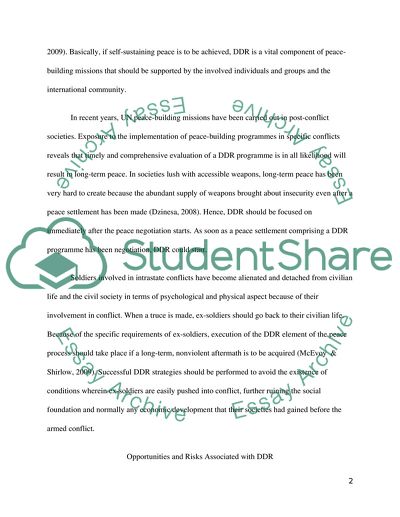Cite this document
(Disarmament, Demobilization, Reintegration - Risks, Opportunities, and Coursework, n.d.)
Disarmament, Demobilization, Reintegration - Risks, Opportunities, and Coursework. Retrieved from https://studentshare.org/social-science/1812735-describe-the-opportunities-and-risks-associeted-with-disarmament-demobilisation-and-reintegration-ddr-in-post-conflict-environments-and-analyse-ways-in-which-the-success-of-ddr-specifically-with-regard-to-its-contribution-to-peacebuilding-can-be-best
Disarmament, Demobilization, Reintegration - Risks, Opportunities, and Coursework. Retrieved from https://studentshare.org/social-science/1812735-describe-the-opportunities-and-risks-associeted-with-disarmament-demobilisation-and-reintegration-ddr-in-post-conflict-environments-and-analyse-ways-in-which-the-success-of-ddr-specifically-with-regard-to-its-contribution-to-peacebuilding-can-be-best
(Disarmament, Demobilization, Reintegration - Risks, Opportunities, and Coursework)
Disarmament, Demobilization, Reintegration - Risks, Opportunities, and Coursework. https://studentshare.org/social-science/1812735-describe-the-opportunities-and-risks-associeted-with-disarmament-demobilisation-and-reintegration-ddr-in-post-conflict-environments-and-analyse-ways-in-which-the-success-of-ddr-specifically-with-regard-to-its-contribution-to-peacebuilding-can-be-best.
Disarmament, Demobilization, Reintegration - Risks, Opportunities, and Coursework. https://studentshare.org/social-science/1812735-describe-the-opportunities-and-risks-associeted-with-disarmament-demobilisation-and-reintegration-ddr-in-post-conflict-environments-and-analyse-ways-in-which-the-success-of-ddr-specifically-with-regard-to-its-contribution-to-peacebuilding-can-be-best.
“Disarmament, Demobilization, Reintegration - Risks, Opportunities, and Coursework”, n.d. https://studentshare.org/social-science/1812735-describe-the-opportunities-and-risks-associeted-with-disarmament-demobilisation-and-reintegration-ddr-in-post-conflict-environments-and-analyse-ways-in-which-the-success-of-ddr-specifically-with-regard-to-its-contribution-to-peacebuilding-can-be-best.


